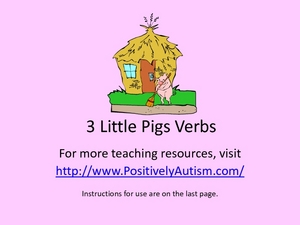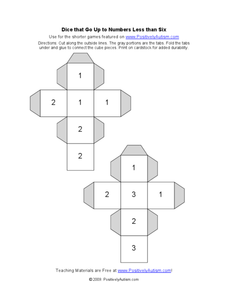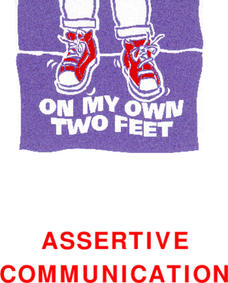Curated OER
Birthday Visual Schedule
Visual schedules can really help an autistic or special-needs child cope with a social event. Focused on birthdays, this resource helps learners know what to expect and what comes next at a birthday party. Additional suggestions are...
Curated OER
Three Little Pigs: Verbs
The story of the Three Little Pigs is a classic. Prep your special education class for a telling of this tale by previewing verbs commonly found in the story. Each page of this printable resource include the verb and an image showing the...
Curated OER
Travis the Train Visits the City in the Spring
Being in a large city may be a lot for a special needs or Autistic student to handle. Prepare them with community integration skills. This social story tells what Travis the Train sees on his visit to the city. Discuss what your pupil...
Curated OER
Rainy Vocabulary
Phonics doesn't always work for everybody. Use this series of rainy day vocabulary words and images to increase your special needs students' sight word vocabulary. Intended for Autistic learners, but useful for any sight reader.
Curated OER
Travis the Train and the Sunny Day
Get your special-needs students thinking about weather appropriate clothing choices with this sunny day social story. Print this resource or use as a slide-show to show children what people wear when its a hot and sunny day. Tip: Use...
Curated OER
ABC Data Sheet
Ever wonder why your special-needs or autistic learners have out bursts in class? Use this ABC Data collection sheet to determine the antecedent, behavior, and consequence to help you determine a possible function for your student's...
Curated OER
A Christmas Song Read Along
Singing, holiday music, family get togethers are all part of typical American Christmas celebrations. Prepare your autistic or special needs class for social engagement through a group sing along. They can build reading skills, rhythm,...
Curated OER
High Frequency Words
Phonemic awareness might not be a skill all autistic children will understand, but pattern and sight word recognition may prove to be more effective means of building strong reading skills. Use this set of twelve high frequency word...
Curated OER
High Frequency Words: Set 3
Here are twelve high frequency words that you can use as a game, flashcards, or to boost word recognition and reading skills. Intended for use with an autistic class but useful for any special needs or early readers. Just print, cut, and...
Curated OER
Train Skip Counting: Count by 5s
Skip counting builds number sense. Have your special needs class skip count by 5s. They count along the 5s train, fill in the missing numbers, then fill in a train completely. Great scaffolding!
Curated OER
Shape Recognition Assessment Tool
Assess and document your autistic or special needs learner's progress toward shape recognition. This assessment prompts the child to circle one shape in a row of three. A simple tool is a quick way to check for understanding.
Curated OER
Game Board: Level 0
Sitting still, taking turns, playing games are all highly valuable social skills. Help the Autistic or special needs child in your class practice these skills one step at a time. This "game board" contains only 5 squares so is perfect...
Curated OER
Make Your Own Dice
Versatility and accessibility are two key components to any good resource. Print, cut, and construct these two large die to play any number of adding or counting games with your special needs class. It doesn't matter if they get torn,...
Curated OER
Dice that Go Up to Numbers Less than Six
Print, cut, and fold this pair of large die. Intended for an Autistic or special needs class, these dice include numbers 1-3 and won't add up to more than 6. This is a great way to engage a child socially as well as academically.
Curated OER
Social Competence
Intended for adults with special needs, but appropriate for upper graders as well, this activity encourages appropriate interpersonal communication. They practice responding to various situations in a role play setting. The lesson...
Curated OER
Purchasing Items Using “One-More-Than” Technique
While the method described to help learners with special needs is sound, it could create unforeseen issues. They are taught through structured practice, how to count out one dollar in coins and then add the dollar amount to it, to...
Curated OER
Cleaning Appliances and Doing Laundry
In an independent living situation or a simulation classroom, special needs individuals practice cleaning household appliances. They clean an oven, refrigerator, and wash a load of laundry with minimal verbal and gestural cues. The...
Curated OER
Selecting Lower Priced Grocery Items
As adults, most individuals with special needs must live on a budget. Provide them with money management skills by teaching your class how to make price comparisons while shopping at the grocery store. They work through a series of...
Curated OER
Counting
Intended for a special education class, but useful for any one learning to identify numbers and count objects up to 10. They count the objects on the right, then draw a line to the correct number on the left. There are four worksheets,...
Curated OER
Home Living / Daily Living: Importance of Keeping a Healthy Body Weight
Prepare your special education class for a healthy life. They visit with a nutritionist, practice simple exercises, and discuss healthy food choices. They then make goals for weight loss and management. Additional supporting activity...
Department of Education (Ireland)
Assertive Communication
Assertive communication is an acquired skill. Teaching young people to ask for what they need and to believe that they have a right to ask is at the core of a unit on assertive communication. Over the course of the unit, middle and high...
Mobile Education Store
SentenceBuilderTeen™
Have you seen a large number of grammatically incorrect sentences in class writing lately? Help alleviate that issue with this app, which is targeted toward teenagers. Class members look at age-appropriate images and choose the correct...
Do2Learn
Self Help: Body Parts
Head and shoulders, knees and...ears? Eyes? Hands? Help learners get the parts of the body straight with this set of 12 picture cards!
Do2Learn
Home & School: Home
From doors and lamps to sinks and chairs, review some of the most common items you'll find in someone's home with this collection of picture cards. It includes 24 images and vocabulary words for learners to place in their appropriate...

























